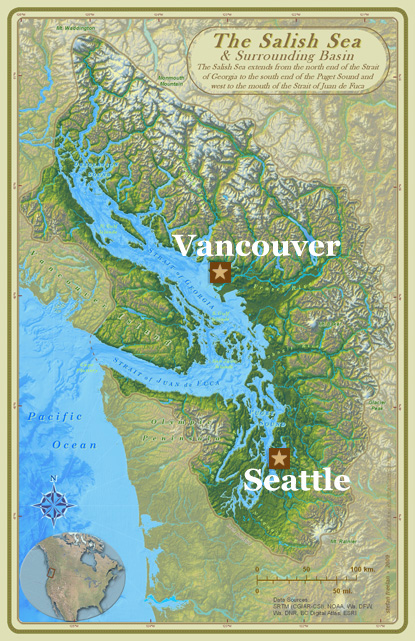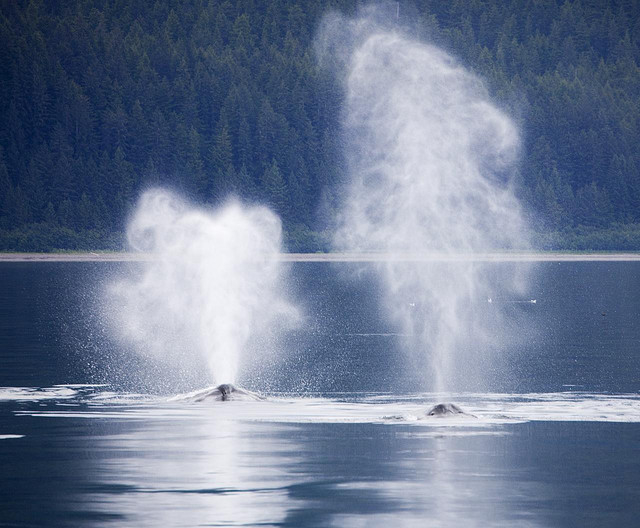By Guest Contributor Charles Wilkinson
In 2009, the National Name Society voted “Salish Sea” as its “Name of the Year.” This Sea encompasses a major and glorious area, reaching from the southern end of Puget Sound, west to the mouth of the Strait of Juan de Fuca, and north to the Strait of Georgia off the eastern coast of Vancouver Island. In one sense, it is a new name, officially adopted in 2009 and early 2010 by the U.S. Board on Geographic Names and, as well, the geographic names boards of Canada, The Province of British Columbia, and the State of Washington. The name also has ancient origins, for Salish people worked these inland waters with their 26-foot cedar canoes for thousands of years. The term “Salish Sea” gradually came into broad use in recent generations, especially in the tourist trade and among scientists and Native people, leading to its official designation. The runner-up name for the 2009 honor? “Twitter.”

The prime advocate for official adoption of the name (which refers to the overall area but does not replace the names of the large water bodies just mentioned or the myriad local bays, inlets, and so forth) was Bert Webber, a marine science professor at Western Washington University in Bellingham, Washington. His reasoning was that the area is a natural geographic feature—an ecosystem—and that the formal designation might cause the two nations, the state, and the province to work more closely on transboundary environmental problems.
For many, the single greatest threat is to the orcas, or killer whales. The Salish Sea, where orcas have been extensively studied, is home to the Southern Resident Community, a clan consisting of three pods, and a Northern Resident Community with 16 pods. The total population numbers perhaps 330 individuals. These mammals, actually large dolphins, weigh about 400 pounds at birth and grow to six tons and 30 feet in length. Orcas are highly communicative, with each community having its own unique language. They also are extremely social: other than human beings, orcas are the only known mammals where mothers maintain contact with their offspring throughout their lifetimes. They are such compelling athletic creatures to our eyes, the pods blasting along with their black dorsal fins cutting through the water at speeds of 30 miles per hour or more and sometimes leaping several feet clear of the surface in their fabled sky hops.
But orcas are in trouble, listed as endangered in the U.S and as a species at risk in Canada. Water pollution is a main cause. With the whales’ need for great amounts of food, scientists believe that the declining numbers of Chinook salmon forces the orcas to travel larger distances in search of food and that the reduced social interaction adversely affects reproduction; several adult females are not bearing calves. Noise from commercial ships and whale-watching boats interferes with communications among the orcas, causing confusion and stress. Close approaches by boats seem to cause more frequent rises, tail slaps, and sky hops, thereby increasing the whales’ energy expenditure and need for food. In 2011, U.S. regulations got stricter, now prohibiting whale-watching boats from approaching closer than 180 meters to the orcas. Canada’s requirement remains at 100 meters for the moment.
The Salish Sea, with its 4600 miles of coastline, offers all manner of opportunities for the outdoor traveler. No fewer than 419 islands create an elaborate seascape that calls out for our contemplation and reflection. Crown jewels include the San Juan Islands of northernmost Washington, favorite destinations for residents of Seattle and other Puget Sound communities. Perhaps even better, because they are lesser-known, are the Gulf Islands of British Columbia, the northern part of a chain that includes the San Juans.
You reach the Gulf Islands, with automobile or without, on the BC Ferries, the largest system of ferry boats in the world. By and large, while all the Gulf Islands—the principal ones include Saltspring, Saturna, Gabriola, Mayne, Galiano, and the Pender Islands—are mostly open farm and ranch country, there is little true wilderness. Still, there are good hiking trails, especially on the 43 parcels that make up the Gulf Islands National Park Reserve, which often lead to overlooks with stirring vistas of the Salish Sea. The islands, with their Mediterranean climate in the rain shadow of mountainous Vancouver Island, also offer biking and kayaking. All of them come equipped with the easy-going, welcoming pace of life that so distinguishes smaller islands. For a fine book on the Pender Islands (the ones I know best), which gives a good feel for the Gulf Islands generally, see Richard Fox, The Pender Islands Handbook (2nd ed.) (Printorium Bookworks, Victoria, BC: 2009).

And then there are the orcas. From May through September, pods work the Gulf Island waters at times that cannot be predicted. But when the big mammals do come, locals (including accommodations hosts) activate phone trees to alert friends and neighbors and head for public parks to watch the handsome, vigorous visitors. Standing on a low cliff, jetty, or dock, you may well be as close or closer than the whale-watching boats. Once, viewing from a jetty on North Pender Island, I was rapt when a pod cruised by, less than fifty yards offshore. Then a bull broke from his colleagues and charged at top speed straight toward a kelp bed right in front of us, where a juicy harbor seal was lounging. “He’s after that seal!” one fellow shouted. But, no more than twenty feet away, the giant veered away and angled back to the pod, leaving our group limp from the display of sheer animal might.
Failing a short-range experience, panning the Sea with binoculars may turn up some orcas, thoroughly exciting even at long distance. One trick is to watch for the whale-watching boats with their red flags. You’ll be able to tell when they make a sighting and you can join in the action with your binoculars.
What a great combination: The magic of the Sea, the slow-going pulse of island time, and the heart-racing arrival of the orcas.
"Ocras on the Edge"
The National Wildlife Federation authored a 2006 article titled "Orcas on the Edge" on the threats to the Orca population in Puget Sound.
For more information on Orcas and the Salish Sea, visit the websites for the Orca Network and the SeaDoc Society.
About the Author: The author of fourteen books on land, water, and society in the American West, Charles Wilkinson is Distinguished University Professor and Moses Lasky Professor of Law at the University of Colorado.
